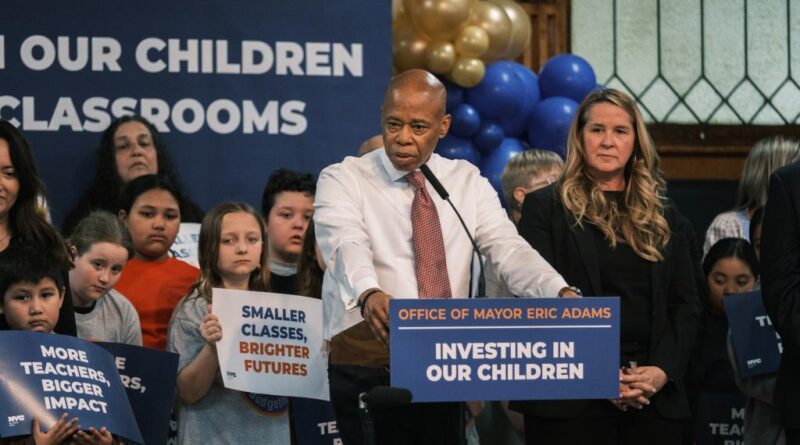Exploring New Worlds Through Reading: How NYC Schools Are Leading the Way

New York City public schools are engaging in a commendable and necessary effort: committing to a positive change for long enough to achieve real results.
Just two years ago, at the conclusion of the 2022-23 academic year, Mayor Adams introduced “NYC Reads,” a crucial initiative aimed at ensuring the implementation of evidence-based, phonics-focused reading programs in every public elementary school throughout the city.
On Monday, this initiative was extended to include middle schools.
This is an unequivocal victory for students and their families, warranting ongoing support, patience, and, most importantly, permanence.
Literacy is the most critical element for success in New York City’s schools.
In a time when screen time is rampant and many public-school students come from low-income households or homes where English is not the primary language, the stakes are high.
There can be no educational equity, no opportunities, and no meaningful learning without proficient reading skills.
For many years, literacy instruction in New York City was heavily influenced by the discredited theories of Lucy Calkins from Columbia Teachers College.
Her “balanced literacy” approach was based on the notion that children can learn to read naturally just by being exposed to interesting books, relying on visual cues and context to guess unfamiliar words. One commentator cleverly referred to it as “vibes-based literacy.”
However, reading is not an innate ability; children don’t learn to decode written language the same way they learn to speak.
The “science of reading” — a research framework grounded in cognitive science and linguistics — demonstrates that systematic phonics and structured literacy instruction are vital, particularly in the early years. Anything less amounts to educational malpractice.
This makes NYC Reads critically important. The city now requires schools to implement one of three approved, evidence-based programs alongside explicit phonics instruction in the early grades.
The program has already reached over 350,000 elementary students citywide. By extending it to middle schools, the initiative ensures that those who may have missed earlier opportunities are still supported.
Admittedly, not everyone supports this change. Some educators express concerns that the mandated curricula lack sufficient “cultural responsiveness,” or that students show less enthusiasm for assigned reading materials compared to choosing their own.
Yet, literacy is the cornerstone of equity. Without it, educational success for children is unattainable.
The pushback highlights how entrenched the old paradigms are — and the challenges involved in getting educators to relinquish beliefs they were trained to uphold.
Some may question whether these reforms are effective. While it’s true that test scores have not skyrocketed, this should not raise alarms. If scores had soared after just one year in the classroom, it would be cause for skepticism.
Language proficiency develops gradually. While phonics is essential, it takes time (especially for disadvantaged students) to cultivate the rich vocabulary and background knowledge across various subjects necessary for advanced reading comprehension.
There are no shortcuts or quick remedies. The key is to remain committed to effective strategies long enough for them to yield results.
The main challenge lies not in adopting a new curriculum, but in implementing it effectively. Changing classroom practices is no small feat.
For years, teachers in New York City were immersed in Calkins’ philosophy. They didn’t mere use her materials; they embraced them.
Retraining tens of thousands of educators requires unlearning deeply held beliefs and adopting new methodologies.
This is why the implementation process is as crucial as the policies themselves. The Department of Education has been actively monitoring classrooms to ensure that the new curricula are in action and instructional shifts are taking place.
These early indicators suggest that NYC Reads is gaining traction, even before test scores reflect the changes. Encouragingly, the United Federation of Teachers has supported teachers during this transition and in their professional growth.
However, the most significant threat to these reforms is not instructional; it’s political.
Adams is running for re-election this year, and NYC Reads is closely tied to his administration.
If he loses, there’s a substantial risk that his successor might abandon or deprioritize this initiative.
New Yorkers must insist that every candidate for mayor pledges to uphold these crucial reforms in education.
If a candidate is noncommittal, it should raise concerns. The current literacy situation is unacceptable in a city where fewer than half of third-graders read at grade level.
NYC Reads represents a long-term effort. To genuinely improve literacy rates, this work must persist across years, mayors, and chancellors.
New York has made a promising start.
The worst action we could take now would be to decelerate — or go off course.
Robert Pondiscio is a senior fellow at the American Enterprise Institute and a former New York City public school teacher.



